
The fortifications of Metz, a city in northeastern France, are extensive, due to the city's strategic position near the border of France and Germany. After the Franco-Prussian War of 1870, the area was annexed by the newly created German Empire in 1871 by the Treaty of Frankfurt and became the Reichsland Alsace–Lorraine. The German Army decided to build a fortress line from Mulhouse to Luxembourg to protect their new territories. The centerpiece of this line was the Moselstellung between Metz and Thionville, in Lorraine.

Ouvrage du Kobenbusch is a gros ouvrage of the Maginot Line, located in the Fortified Sector of Thionville in the Cattenom Forest. It possesses seven combat blocks and two entrance blocks, one for ammunition and the other for men. It is located between petit ouvrage Bois-Karre and petit ouvrage Oberheid, and was named for the surrounding Kobenbusch Forest.
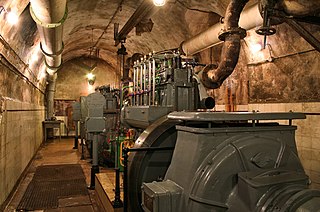
Ouvrage Michelsberg, one of the Maginot Line fortifications, formed part of the Fortified Sector of Boulay as well as the fortified region of Metz. The ouvrage is located in Moselle (département) between the towns of Dalstein and d'Ebersviller, about 23 km from Thionville. It is located between gros ouvrage Mont des Welches and petit ouvrage Hobling, facing Germany. Michelsberg did not see significant action in the Battle of France until June 1940, when it was attacked from the rear by German forces that had bypassed the Maginot Line. It successfully resisted these attacks, but was compelled to surrender in accordance with the 25 June 1940 armistice. After the Second World War it was renovated as a Cold War fortification against a potential Soviet invasion, then abandoned. It is now operated as a museum, and may be visited.
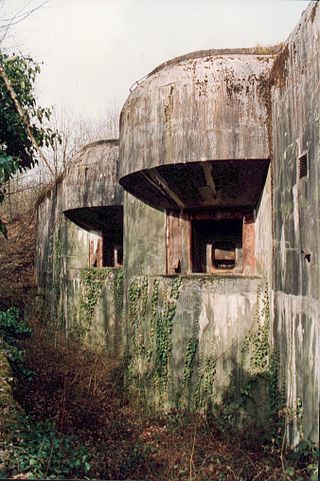
Ouvrage Billig, a gros ouvrage or large fortification of the Maginot Line, was located in the Fortified Sector of Thionville, Moselle in northern France. It is located between the gros ouvrages Metrich and Hackenberg, facing Germany. It saw relatively little action during World War II and after a period of reserve duty in the 1950s, was abandoned in the 1970s.

Ouvrage Métrich located in the village of Kœnigsmacker in Moselle, comprises part of the Elzange portion of the Fortified Sector of Thionville of the Maginot Line. A gros ouvrage, it is the third largest of the Line, after Hackenberg and Hochwald. It lies between petit ouvrage Sentzich and gros ouvrage Billig, facing Germany. Located to the east of the Moselle, it cooperated with Ouvrage Galgenberg to control the river valley.
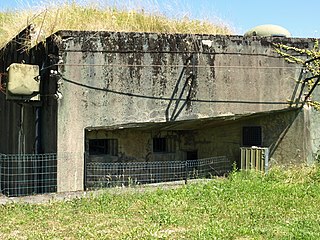
Ouvrage Sentzich is part of the Fortified Sector of Thionville of the Maginot Line. The petit ouvrage for infantry is located to the south of gros ouvrage Galgenberg, on the edge of the main road to Luxembourg near the village of Sentzich. Gros ouvrage Métrich is to the east. As a small work, it was not considered for use after World War II and was abandoned. It is secured and is not open to the public.

Ouvrage Rochonvillers is one of the largest of the Maginot Line fortifications. Located above the town of Rochonvillers in the French region of Lorraine, the gros ouvrage or large work was fully equipped and occupied in 1935 as part of the Fortified Sector of Thionville in the Moselle. It is located between the petit ouvrage d'Aumetz and the gros ouvrage Molvange, facing the border between Luxembourg and France with nine combat blocks. Rochonvillers saw little action during World War II, but due to its size it was repaired and retained in service after the war. During the Cold War it found a new use as a hardened military command centre, first for NATO and then for the French Army.

Ouvrage Immerhof, also known as Ouvrage Ferme-Immerhof, is one of the largest petit ouvrages of the Maginot Line of north-east, France. Located near the community of Hettange-Grande, it is 7 km north of Thionville between the gros ouvrages of Molvange and Soetrich, the closest ouvrage to the Luxembourg frontier. It was part of the Fortified Sector of Thionville, in the Fortified Region of Metz, the strongest portion of the Line. Apart from its function as a communication post between the neighbouring gros ouvrages, Immerhof also controlled the road and railway routes from Luxembourg, which pass in the immediate vicinity. In addition, Immerhof protected other Maginot works in the vicinity: the casemates of Kanfen, the infantry shelter of Stressling, the observation point and shelter of Hettange-Grande, and a number of nearby blockhouses constructed during the Phoney War.

Ouvrage Oberheid, also called Ouvrage Oberheide, forms a portion of the Fortified Sector of Thionville of the Maginot Line in northeast France. The petit ouvrage d'infanterie is located on a salient point of the Cattenom Forest between the gros ouvrages Kobenbusch and Galgenberg, which provided covering fire during June 1940, when Oberheid faced daily bombardments and infiltrations. Oberheid has been abandoned and after extensive vandalism has been sealed.

Ouvrage Galgenberg forms a portion of the Fortified Sector of Thionville of the Maginot Line. It is situated in the Cattenom Forest, near the gros ouvrage Kobenbusch and petit ouvrage Oberheid. The ouvrage was tasked with controlling the Moselle Valley and as such was called the "Guardian of the Moselle." Galgenberg did not see significant action in 1940 or 1944. After a period of reserve duty in the 1950s and 1960s, it was deactivated. It is now a museum.
The Fort de Koenigsmacker is a fortification located to the northeast of Thionville in the Moselle department of France. It was built by Germany next to the town of the same name in the early 20th century after the annexation of the Moselle following the Franco-Prussian War. The Fort de Koenigsmacker was part of the Moselstellung, a group of eleven fortresses surrounding Thionville and Metz to guard against the possibility of a French attack aimed at regaining Alsace and Lorraine, with construction taking place between 1908 and 1914. The fortification system incorporated new principles of defensive construction to deal with advances in artillery. Later forts, such as Koenigsmacker, embodied innovative design concepts such as dispersal and concealment. These later forts were designed to support offensive operations, as an anchor for a pivoting move by German forces into France.
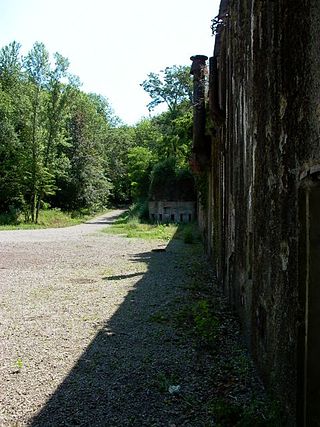
The Fort d'Illange is a fortification located to the south of Thionville in the Moselle department of France. It was built by Germany next to the town of Illange in the early 20th century after the annexation of the Moselle following the Franco-Prussian War. The Fort d'Illange was part of the Moselstellung, a group of eleven fortresses surrounding Thionville and Metz to guard against the possibility of a French attack aimed at regaining Alsace and Lorraine, with construction taking place between 1905 and 1911. The fortification system incorporated new principles of defensive construction to deal with advances in artillery. Later forts, such as Illange, embodied innovative design concepts such as dispersal and concealment. These later forts were designed to support offensive operations, as an anchor for a pivoting move by German forces into France.
Fort Jeanne d'Arc, also called Fortified Group Jeanne d'Arc, is a fortification located to the west of Metz in the Moselle department of France. It was built by Germany to the west of the town of Rozérieulles in the early 20th century as part of the third and final group of Metz fortifications. The fortification program was started after the German victory of the Franco-Prussian War, which resulted in the annexation of the provinces of Alsace and Lorraine from France to Germany. The Fort Jeanne d'Arc was part of the Moselstellung, a group of eleven fortresses surrounding Thionville and Metz to guard against the possibility of a French attack aimed at regaining Alsace and Lorraine, with construction taking place between 1899 and 1908. The fortification system incorporated new principles of defensive construction to deal with advances in artillery. Later forts, such as Jeanne d'Arc, embodied innovative design concepts such as dispersal and concealment. These later forts were designed to support offensive operations, as an anchor for a pivoting move by German forces into France.

The Fortified Sector of Thionville was the French military organisation that in 1940 controlled the section of the Maginot Line immediately to the north of Thionville. The sector describes an arc of about 25 kilometres (16 mi), about halfway between the French border with Luxembourg and Thionville. The Thionville sector was the strongest of the Maginot Line sectors. It was surrounded but not seriously attacked in 1940 by German forces in the Battle of France, whose main objective was the city of Metz. Despite the withdrawal of the mobile forces that supported the fixed fortifications, the sector successfully fended off German assaults before the Second Armistice at Compiègne. The majority of the positions and their garrisons finally surrendered on 27 June 1940, the remainder on 2 July. Following the war, many positions were reactivated for use during the Cold War. Four locations are now preserved and open to the public.
The Fortified Sector of Lille was the French military organization that in 1940 controlled the section of the French border with Belgium opposite Lille. The sector was part of a system of fortifications that included the Maginot Line in other sectors. In the case of the Lille sector, no large fortifications of the kind typified by the Maginot Line were built in the area. Fortifications were confined to a total of 65 blockhouses and 23 infantry shelters within a few kilometers of the border, mainly between Roubaix and Tourcoing and the border. The Fortified Sector of Lille was bordered on the east by the Fortified Sector of the Escaut and on the west by the Fortified Sector of Flanders. The sector figured in the Pillbox affair of 1939-40. It was quickly overrun by German forces during the Battle of France.
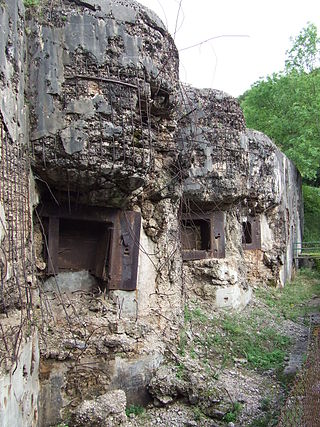
The Fortified Sector of Boulay was the French military organization that in 1940 controlled the section of the Maginot Line to the north and east of Metz in northeastern France. The left (western) wing of the Boulay sector was among the earliest and strongest portions of the Maginot Line. The right wing, started after 1931, was progressively scaled back in order to save money during the Great Depression. It was attacked in 1940 by German forces in the Battle of France. Despite the withdrawal of the mobile forces that supported the fixed fortifications, the sector successfully fended off German assaults before the Second Armistice at Compiègne. The positions and their garrisons finally surrendered on 27 June 1940. Following the war many positions were reactivated for use during the Cold War. Three locations are now preserved and open to the public.

The Fortified Region of Metz comprised the central and most heavily fortified portion of the Maginot Line. The region was established in 1926 as a military organization for the French fortifications along the frontier with Luxembourg and Germany to the east of Longuyon in northeastern France, forming a shield to the north of the industrialized areas of Metz and Thionville. The region was dissolved as a military organization on 18 March 1940, its command personnel moving to the 42nd Army Corps.
The Feste Prinz Regent Luitpold, renamed Group Fortification Yser after 1919, is a military installation near Metz. It is part of the second fortified belt of forts of Metz and had its baptism of fire in late 1944, when the Battle of Metz occurred.
The Infanterie-Werk Belle-Croix, renamed Fort Lauvallière after 1919, is a military installation near Metz. It is part of the second fortified belt of forts of Metz.
The forts of Metz are two fortified belts around the city of Metz in Lorraine. Built according to the design and theory of Raymond Adolphe Séré de Rivières at the end of the Second Empire—and later Hans von Biehler while Metz was under German control—they earned the city the reputation of premier stronghold of the German reich. These fortifications were particularly thorough given the city's strategic position between France and Germany. The detached forts and fortified groups of the Metz area were spared in World War I, but showed their full defensive potential in the Battle of Metz at the end of World War II.













